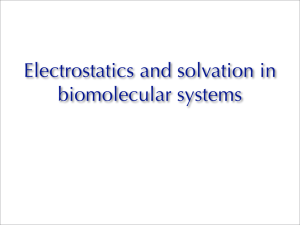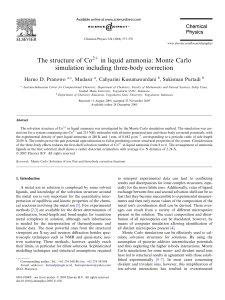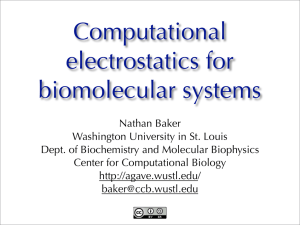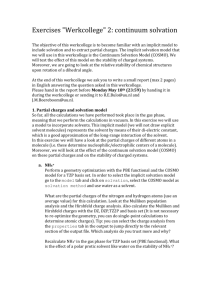Electrostatics and solvation for biomolecular systems BIO 5325 Sept. 26, 2006
advertisement
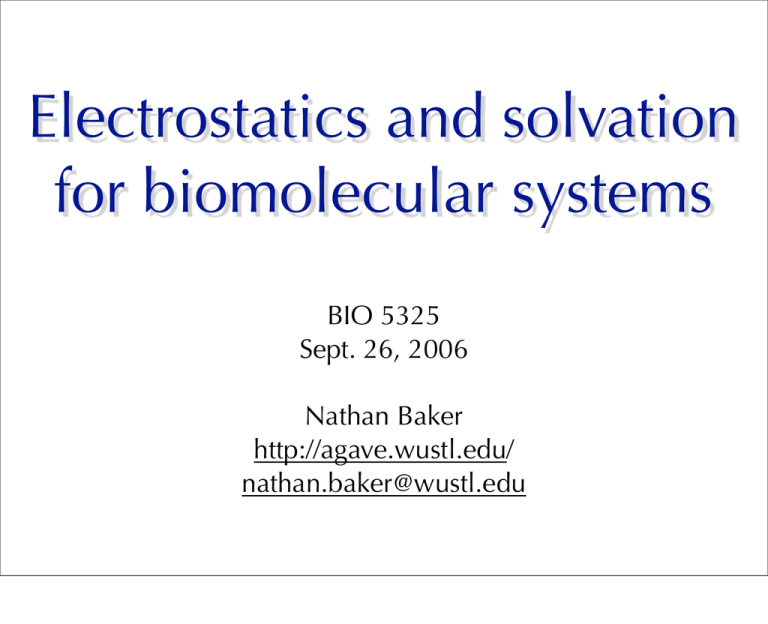
Electrostatics and solvation for biomolecular systems BIO 5325 Sept. 26, 2006 Nathan Baker http://agave.wustl.edu/ nathan.baker@wustl.edu Baker group Mike Bradley Molecular biophysics grad student Sun Joo Lee Molecular biophysics grad student Rachel Rice Molecular biophysics grad student Todd Dolinsky Programmer Peter Jones Programmer Yuhua Song Asst. Prof., Univ. Alabama Feng Dong Postdoc Brett Olsen Molecular & cell biology grad student Jason Wagoner Grad. student, Stanford Baker group research Multiscale modeling How can continuum methods be systematically integrated with atomic-detail simulations in regions of interest? What are the limits of validity for continuum methods? What do we learn about the physics and chemistry of these systems through such integration? The solutions depend on the questions! Biological “signaling” Allosteric proteins Diffusion Water and ions Electrostatics Solvation Electromechanical coupling Electrostatics in biomolecular interactions Highly relevant to biological function Important tools in interpretation of structure and function Challenging computational problem: long-ranged and divergent Acetylcholinesterase and fasciculin-2 Where do electrostatics matter? Computational applications Thermodynamics: Solvation Binding Acid/base equilibria Conformational changes Kinetics Binding Conformational changes Movie courtesy of Dave Sept How solvent interacts with biomolecules Water properties Dipolar solvent (1.8 D) Hydrogen bond donor and acceptor Polarizable Functional behavior: Bulk polarization Site binding or specific solvation Preferential hydration Acid/base chemistry ... Spine of hydration in DNA minor groove (Kollman, et al.) Carbonic anhydrase reaction mechanism (Stryer, et al.) How ions interact with biomolecules Non-specific screening effects Depends only on ionic strength (not species) Results of damped electrostatic potential Described by Debye-Hückel or Poisson-Boltzmann theories for low ionic strengths Functional behavior: Described throughout lectures Binding constants Rates 10 Electrostatic potential of AChE at 0 mM and 150 mM NaCl. Rate and binding affinity decrease with [NaCl] has been attributed to screening effects… although speciesdependent influences have been observed. Radic Z, et al. 1997. J Biol Chem 272 (37): 23265-77. How ions interact with biomolecules Site-specific binding Ion-specific Site geometry, electrostatics, coordination, etc. enables favorable binding Functional behavior: co-factors, allosteric activation, folding, etc. Site of sodium-specific binding in thrombin. Sodium binding converts thrombin to a procoagulant form by allosterically enhancing the rate and changing substrate specificity. Pineda AO, et al. 2004. J Biol Chem 279 (30): 31842-53. Draper DE, et al. 2005. Annu. Rev. Biophys. Biomol. Struct. 34: 221-43. 11 Rep + ATP kinetics influenced by specific interactions of divalent anions with ATP binding site. Moore KJM, Lohman TM. 1994. Biochemistry 33 (48): 14565-78. How ions interact with biomolecules Hofmeister effects (preferential hydration) How much salt is required to precipitate a protein? It depends on the salt... Partitioning of ions between water and nonspecific sites on biomolecule Dependent on ion type (solvation energy, etc.) Dominate at high salt concentrations Functional behavior: protein stability, membrane structure and surface potentials, protein-protein interactions Friedrich Hofmeister (1782-1864) most stabilizing most destabilizing strongly solvated anions weakly solvated anions citrate2- > SO42- > PO42- > F- > Cl- > Br- > I- > NO3- > ClO4N(Me)4+ > NH4+ > Cs+ > Rb+ > K+ > Na+ > H+ > Ca2+ > Mg2+ > Al3+ weakly solvated cations Adapted from http://www.lsbu.ac.uk/water/hofmeist.html 12 strongly solvated cations Implicit solvent models: basic overview Modeling biomolecule-solvent interactions Increasing detail, cost Solvent models Quantum Explicit Ion models Quantum Explicit Polarizable Fixed charge Integral equation Polarizable Fixed charge Integral equation RISM 3D methods DFT RISM 3D methods DFT Primitive Field-theoretic Poisson equation Extended models Poisson-Boltzmann equation Phenomenological Generalized Born, et al Modified Coulomb’s law Phenomenological Generalized Born, et al Modified Debye-Hückel 14 Explicit solvent simulations Sample the configuration space of the system: ions, atomically-detailed water, solute Sample with respect to a particular ensemble: NpT, NVT, NVE, etc. Molecular dynamics or Monte Carlo Advantages: High levels of detail Additional degrees of freedom readily included All interactions are explicit Disadvantages Slow and uncertain convergence Boundary effects Poor scaling Some effects still not considered in may force fields... 15 Electrostatics in a dielectric continuum Continuum dielectric... Has no atomic detail Is related to the polarization of the medium: redistribution of charges Responds linearly and locally to dampen an applied field Is characterized by a dielectric tensor Reduces the strength of electrostatic interactions relative to a vacuum 16 Solvation free energies Implicit solvent models “Potentials of mean force” and solvation free energies Mean forces Free energy cycle (as function of conformation) Cavity creation Dispersive interactions Charging process Adapted from: Levy RM, Zhang LY, Gallicchio E, Felts AK. 2003. J Am Chem Soc 125 (31): 9523-9530. Poisson equation Classic equation of continuum electrostatics Can be derived from more microscopic models Assumptions: No dielectric saturation (linear response) No solvent-solvent correlation (local response) No atomic detail, hydrogen bonding, chemistry, etc. Dielectric constants 120 Several contributions to polarizability 96 72 48 24 (2 Fo 0 C rm ) W am id at e er Fo (2 rm 5 ic C ac ) i G d (1 lyc 6 N ol C itr (2 ) ob 5 en C z ) M en et e ( ha 25 no C H l (2 ) ep ta 5 C ne ) ( Ai 0 C r( ) 0 C ) 0 H C N Electronic polarizability Intramolecular rearrangement Reorientation of permanent dipole moment Hydrogen bonding networks 19 Molecular dielectric coefficients A heterogeneous molecule like a biomolecule shouldn’t really be represented by a continuum dielectric… …however, that doesn’t keep people from trying Multiple dielectric values: 1 = vacuum 2-4 = atomic polarizability (solid) 4-10 = some libration, minor sidechain rearrangement 10-20 = significant internal rearrangement Multiple surface definitions: van der Waals Splines Molecular surface 20 Poisson-Boltzmann equation Mean field model Include “mobile” charges Boltzmann distribution Ignore charge-charge correlations Infinitesimal size Weak ion-ion electrostatic interactions Low densities Missing ion “chemistry” No detailed ion-solute or ion-solvent interactions No ion coordination, etc. The Poisson-Boltzmann equation: methods Poisson-Boltzmann coefficients Baker NA, Meth Enzymology, 383, 94-118, 2004; Baker NA, Curr Opin Struct Biol, 15, 137-43, 2005. Equation coefficients: “fixed” charge distribution Charges are modeled as delta functions: hard to represent Often discretized as splines to “smooth” the problem Higher-order charge distributions also possible 24 Equation coefficients: mobile ion distribution Usually assume a single exclusion function for all ions Generally based on inflated van der Waals radii 25 Equation coefficients: dielectric function Describes change in local polarizability Low dielectric interior (2-20) High dielectric exterior (80) Many definitions Molecular Solvent-accessible van der Waals Smoothed (Gaussian, spline) Results can be very sensitive to surface definition! 26 Basic steps 1. Determine the coefficients based on the biomolecular structure 2. Discretize the problem 3. Solve the resulting linear or nonlinear algebraic equations 27 Discretization methods Locally supported polynomial basis functions Sparse matrices Boundary element methods Finite element methods (Holst group FEtk) Multigrid (Holst group PMG) Holst M, et al. J Comput Chem 21, 1319-42, 2000; Baker N, et al. J Comput Chem 21, 1343-52, 2000. Numerical solvers Holst group software (FEtk and PMG) Iteratively solve algebraic systems: Linear: multigrid Nonlinear: Newton’s method and multigrid Multigrid solvers offer optimal solution Big systems are still difficult Significant memory Long run-times Need parallel solvers Errors in numerical solutions Electrostatic potentials are very sensitive to discretization Grid spacings < 0.5 Å Smooth surface discretizations Errors most pronounced next to a biomolecule Large potential and gradients High multipole order Errors decay with distance 30 Focusing New parallel solution methods “Focusing” concept: low-resolution solutions acceptable for boundary conditions Similar to Bank-Holst parallel method Focusing Given the problem data and P processors of a parallel machine: Each processor i = 1, …, P: Obtains a coarse solution over the global domain Subdivides the global domain into P subdomains, each of which is assigned a processor Assigns boundary conditions to a fine discretization of its subdomain using the coarse global solution Solves the equation on its subdomain A master processor collects observable data from other processors and controls I/O Very good linear scaling Parallel focusing Baker NA, et al, Proc Natl Acad Sci USA, 98, 10037-41, 2001; Sept D, et al, Protein Sci, 12, 2257-61, 2003; Konecny R, et al, Biopolymers, 82, 106-20, 2006. Electrostatics software Software package Description URL Availability APBS FD & FE MG http://apbs.sf.net/ Free, open source DelPhi FD GS http:// trantor.bioc.columbia.edu/ delphi $250 academic MEAD FD SOR http://www.scipps Free, open source UHBD FD SOR http://mccammon.ucsd.edu/ uhbd.html $300 academic Jaguar FE MG, SOR, CG http://schrodinger.com Commercial CHARMM FD MG http://yuri.harvard.edu $600 academic AMBER FD http://amber.scripps.edu $400 academic 34 Electrostatics software APBS (http://apbs.sf.net/) PB electrostatics calculations Fast finite element and multigrid solvers from Holst group Web-based interface (Gemstone, Baldridge group & NBCR) Works with most popular visualization software (VMD, PMV, PyMOL) Links with CHARMM, AMBER, TINKER PDB2PQR (http://pdb2pqr.sf.net/) Prepares PDB files for other calculations Assigns titration states (PROPKA) and optimizes hydrogen positions “Repairs” missing heavy atoms Web-based and command-line Baker NA, et al, Proc Natl Acad Sci USA, 98, 10037-41, 2001; Dolinsky TJ, et al, Nucl Acids Res, 32, W665-7, 2004. The Poisson-Boltzmann equation: applications Inspection of ligand binding sites Balanol protein kinase A binding (Wong CF, et al. J Med Chem 44, 1530-9 (2001) NikR Ni(II) and DNA binding 37 Quantitative comparison of electrostatic potentials Do electrostatic potentials tell us anything about biomolecular function? Ligand binding Active sites or shifted pKas? Structural (de)stabilization? PH domain comparison: similar fold, similar electrostatics, different sequence. Blomberg N, et al. Proteins 37, 379-877 (1999). Putative Mg++ and RNA binding domains in an unclassified protein. Elcock AH, J Mol Biol 312, 885-96 (2001). SOD comparison. Livesay DR, et al. Biochemistry 42, 3464-73 (2003) 38 Multiresolution contour trees 39 Free energy cycles At the heart of most calculations... ...because we can’t usually directly calculate the quantity of interest Most important principle: Energy is a state function Integral of energy changes over a closed cycle is zero 40 A B D C Solvation free energy cycle elec,s vdw,s sol cav elec,v vdw,v 41 Solvation energies Absolute energies are generally not useful: inaccurate Solvation: an excellent way to remove “self energies” Building block for most electrostatics calculations “Total energies” can be recovered by adding in vacuum polar and nonpolar contributions 42 Absolute binding free energy cycle 43 Binding energies Separate calculation into two steps: Calculate electrostatic interaction for homogeneous dielectric (Coulomb’s law) Calculate solvation energy change upon binding Self-interactions are removed in solvation energy calculation Absolute binding energies are tricky... 44 Relative binding free energy cycle Usually better accuracy Cancellation of numerical errors Cancellation of hardto-quantify terms Useful for predicting mutations, changes in functional groups, etc. 45 Application to ribosomes Ribosome central to protein synthesis machinery Target for several pharmaceuticals Nucleoprotein composition make it computationally challenging Composed of two subunits (large and small): 30S consists of 88,000 atoms and roughly 200 Å cube 50S consists of more than 95,000 atoms and roughly 200 Å cube Function involves several interesting features: Protein-nucleic acid association Protein-protein association Conformational changes Salt dependence (type and quantity) Solved on 343 processors of Blue Horizon to 0.41 Å (30S) and 0.43 Å (50S) resolution Baker NA, et al, Proc Natl Acad Sci USA, 98, 10037-41, 2001; Ma C, et al, J Am Chem Soc, 124, 1438-42, 2002. Ribosome-antibiotic binding Determine binding energies between 30S ribosomal subunit and aminoglycoside antibiotics Good agreement for experimental and computational relative binding free energies: 0.78 ± 0.13 slope with small molecules, 0.95 ± 0.19 slope without Suggests importance of basic groups on Ring IV Baker NA, et al, Proc Natl Acad Sci USA, 98, 10037-41, 2001; Ma C, et al, J Am Chem Soc, 124, 1438-42, 2002. Application to microtubules Important cytoskeletal components: structure, transport, motility, division Typically 250-300 Å in diameter and up to millimeters in length Computationally difficult due to size (1,500 atoms Å-1 ) and charge (-4.5 e Å-1) Solved LPBE at 150 mM ionic strength on 686 processors for 600 Å-long, 1.2-million-atom microtubule Resolution to 0.54 Å for largest calculation: quantitative accuracy Baker NA, et al, Proc Natl Acad Sci USA, 98, 10037-41, 2001; Sept D, et al, Protein Sci, 12, 2257-61, 2003. 48 Microtubule stability and assembly Collaboration with Andy McCammon (UCSD) and Dave Sept (Wash U BME) Performed series of calculations on tubulin dimers and protofilament pairs Poisson-Boltzmann electrostatics and SASA apolar energies Observed 7 kcal/mol stronger interactions between protofilaments than within Determined energetics for helix properties; predict correct minimum for experimentally-observed A (52 Å) and B (8-9 Å) lattices Baker NA, et al, Proc Natl Acad Sci USA, 98, 10037-41, 2001; Dolinsky TJ, et al, Nucl Acids Res, 32, W665-7, 2004. 49 pKa calculations αAmino acid carboxylic acid Want acid dissociation constant for residues in a particular structural context Use “model” pKas for amino acids Calculate “intrinsic” pKa from two calculations: Binding of unprotonated residue Binding of protonated residue Calculate titration state and actual from sampling of coupled pKas Conformational distributions can matter 50 α-amino Side chain Alanine 2.35 9.87 Arginine 2.01 9.04 Asparagine 2.02 8.80 Aspartic acid 2.10 9.82 3.86 Cysteine 2.05 10.25 8.00 Glutamic acid 2.10 9.47 4.07 Glycine 2.35 9.78 Histidine 1.77 9.18 Isoleucine 2.23 9.76 Leucine 2.33 9.74 Lysine 2.18 8.95 Methionine 2.28 9.21 Phenylalanine 2.58 9.24 Proline 2.00 10.60 Serine 2.21 9.15 Threonine 2.09 9.10 Tryptophan 2.38 9.39 Tyrosine 2.20 9.11 Valine 2.29 9.72 12.48 6.10 10.53 10.07 pKa calculations 51 Implicit solvent models: how well do these really work? Implicit solvent questions Where is the molecular detail of solvent and ions important? Where does nonlinear solvent/ion response matter? What is the correct description of nonpolar solvation? Ultimate goal: what is the correct interface between implicit/explicit solvent methods? Solvation free energies Implicit solvent models “Potentials of mean force” and solvation free energies Mean forces Free energy cycle (as function of conformation) Cavity creation Dispersive interactions Charging process Adapted from: Levy RM, Zhang LY, Gallicchio E, Felts AK. 2003. J Am Chem Soc 125 (31): 9523-9530. Nonpolar solvation: basic concepts “Oil and water” Solubility has temperature minimum Large positive heat capacity Temperature-sensitive structuring of water Ar solvation and “iceberg model” figures from: Dill KA, et al. 2005. Modeling water, the hydrophobic effect, and ion solvation. Annu Rev Biophys Biomol Struct. Nonpolar solvation: implementation Cavity terms Area times surface tension; usually between 25 to 50 cal mol-1 Å-2 (model-dependent) Volume and pressure; not commonly used Dispersion terms WCA-like treatment: attractive potential integrated over solute-solvent distribution function for “hard” solute Approximation: integral of attractive potential over solvent-accessible space Wagoner JA, Baker NA. Proc Natl Acad Sci USA, 103, 8331-6, 2006. Nonpolar solvation: alkanes 4 Alkane nonpolar solvation energy (kcal/mol) 3 2 Wagoner JA, Baker NA. Proc Natl Acad Sci USA, 103, 8331-6, 2006. Cyclohexane Cyclopentane Neopentane 2-methylbutane Implicit (WCA) Explicit (OPLS) Experiment Isobutane Hexane Pentane Butane Propane 0 Ethane 1 Methane Not very glamorous... ...but (relatively) easy to study. Good agreement with explicit solvent methods OK agreement with experiment IFABP solvation NMR structures (PDB ID 1AEL) Highly solvated biomolecule Molecular dynamics simulations Conformational clustering Charged protein Uncharged protein Solvation forces Polar Nonpolar IFABP polar solvation Wagoner JA, Baker NA, J Comput Chem, 25, 1623-9, 2004; Swanson JMJ, et al, submitted. IFABP nonpolar solvation WCA parameters: γ = 3 cal mol-1 Å-2, p = 36 cal mol-1 Å-3, σ = 1.13 Å Wagoner JA, Baker NA. Proc Natl Acad Sci USA, 103, 8331-6, 2006. IRE solvation IRE hairpin Molecular dynamics simulation (AMBER94) agrees well with NMR data No specific divalent metal requirement Showalter et al, J Biomol NMR, 32, 179-93, 2004. IRE polar solvation IRE nonpolar solvation Same WCA parameters as IFAPB: γ = 3 cal mol-1 Å-2, p = 36 cal mol-1 Å-3, σ = 1.13 Å Summary Do implicit solvent models “work”? Successes Previous applications Protein polar solvation forces Protein and RNA nonpolar solvation forces (new model) Alkane solvation energies Failures RNA polar solvation forces RNA and DNA ion densities Specific ion binding Acknowledgments People Todd Dolinsky Feng Dong Dave Gohara Jason Wagoner Funding NIGMS NBCR Sloan Foundation Collaborators Chandrajit Bajaj Mike Holst Jan Jensen Andy McCammon Jens Nielsen Rohit Pappu Jay Ponder Dave Sept Xiaoyu Zhang
